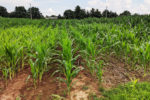Advertise Follow Us
Items Tagged with 'ethanol'
ARTICLES
Update to U.S. tax credit mandates use of no-till, cover crops & efficient fertilizer for ethanol production to receive premium
Read More
Check Your No-Till Residue Armor Before Considering Stover Harvest
Measure residue coverage in no-till fields to ensure the soil is protected without inhibiting the planting process or causing future crop emergence and stand issues.
Read More









